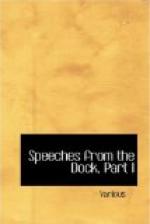Amongst the men who had rallied round James Stephens in America there were many whose honesty was untainted, and who had responded to his call with the full intention of committing themselves, without regard to consequences, to the struggle which he promised to initiate. They believed his representations respecting the prospects of an insurrection in Ireland, and they pledged themselves to fight by his side and perish, if necessary, in the good old cause, in defence of which their fathers had bled. They scorned to violate their engagements; they spurned the idea of shrinking from the difficulty they had pledged themselves to face, and resolved that come what may the reproach of cowardice and bad faith should never be uttered against them. Accordingly, in January, ’67, they began to fend in scattered parties at Queenstown, and spread themselves through the country, taking every precaution to escape the suspicion of the police. They set to work diligently and energetically to organize an insurrectionary outbreak; they found innumerable difficulties in their path; they found the people almost wholly unarmed; they found the wisest of the Fenian leaders opposed to an immediate outbreak, but still they persevered. How ably they performed their work there is plenty of evidence to show, and if the Irish outbreak of ’67 was short-lived and easily suppressed, it was far from contemptible in the pre-concert and organization which it evidenced.
One hitch did occur in the accomplishment of their designs. On Wednesday, February 13th, the exciting news was flashed throughout the land that the Fenians had broken into insurrection at Kerry. The news was true. The night of the 12th of February had been fixed for a simultaneous rising of the Fenians in Ireland; but the outbreak had been subsequently postponed, and emissaries were despatched to all parts of the country with the intelligence of the change of date. The change of date was everywhere learned in time to prevent premature action except at Cahirciveen, in the west of Kerry, where the members of the Brotherhood, acting upon the orders received, unearthed their arms, and gaily proceeded towards Killarney to form a junction with the insurgents whom they imagined had converged from various parts of the county in that town. Before many hours had elapsed they discovered their mistake—they heard before arriving at Killarney that they were the only representatives of the Irish Republic that had appeared in the field, and turning to the mountains they broke up and disappeared.
Short-lived as was their escapade, it filled the heart of England with alarm. In hot haste the Habeas Corpus Suspension Act, which had been permitted to lapse a month before, was re-enacted; the arrests and police raids was renewed, and from the Giant’s Causeway to Cape Clear the gaols were filled with political prisoners. Still the Irish-Americans worked on; some of them were swept off to prison, but the greater number of them managed to escape detection, and spite of the vigilance of the authorities, and the extraordinary power possessed by the government and its officials, they managed to carry on the business of the organization, to mature their plans, and to perfect their arrangements for the fray.




